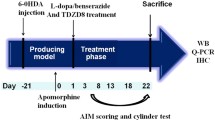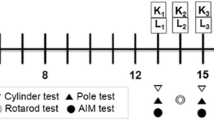Abstract
Chronic l-3,4-dihydroxyphenylalanine (l-DOPA) treatment of Parkinson’s disease (PD) often results in debilitating involuntary movements known as l-DOPA-induced dyskinesia (lID), which is the main obstacle in PD. The abnormal involuntary movements (AIMs) are consistently involved with the activation of the Ras-extracellular signal-regulated kinase 1/2 (ERK1/2) mitogen-activated protein kinase (MAPK) signaling pathway. Previous research has also shown that blockade of ERK phosphorylation could reduce the induction of lID. Consequently, inhibitors of MAPK signaling cascade that block the aberrant supersensitive response of direct pathway striatal neurons could provide a novel therapeutic adjunct to l-DOPA in the treatment of PD. Statins, a specific inhibitor of the rate-limiting enzyme in cholesterol biosynthesis, can also inhibit Ras isoprenylation and activity, and the subsequent phosphorylation of ERK1/2 (pERK1/2). Simvastatin, a representative of statins, could reduce l-DOPA-induced AIM incidence and severity in the 6-hydroxydopamine (6-OHDA) rat model of PD by preventing the l-DOPA/benserazide-induced increase in pERK1/2 levels in our study. The simvastatin-l-DOPA/benserazide-treated 6-OHDA animals displayed less severe rotational behavior and a dramatic reduction in AIM severity than the l-DOPA/benserazide-treated ones. This lower AIM severity was related to a decrease in l-DOPA-induced increase in the following: (1) striatal pERK1/2 and (2) FosB levels. These results suggest that simvastatin could represent a treatment option for managing lID in PD.


Similar content being viewed by others
References
Bezard E, Brotchie JM, Gross CE (2001) Pathophysiology of levodopa-induced dyskinesia: potential for new therapies. Nat Rev Neurosci 2:577–588
Westin JE, Vercammen L, Strome EM, Konradi C, Cenci MA (2007) Spatiotemporal pattern of striatal ERK1/2 phosphorylation in a rat model of l-DOPA-induced dyskinesia and the role of dopamine D1 receptors. Biolpsychiatry 62:800–810
Dai Y, Khanna P, Chen S, Pei XY et al (2007) Statins synergistically potentiate 7-hydroxystaurosporine(UCN-01)lethality in human leukemia and myeloma cells by disrupting Ras farnesylation and activation[J]. Blood 109(10):4415–4423
Thomas J, Wang J, Takuba H et al (1994) A 6-OHDA induced selective Parkinsonian rat model further biochemical and behavioural characterization. J Exp Neurol 126:159–167
Cenci MA, Lee CS, Bjorklund A (1998) l-DOPA-induced dyskinesia in the rat is associated with striatal overexpression of prodynorphin- and glutamic acid decarboxylase mRNA. Eur J Neurosci 10:2694–2706
Lindholm P, Voutilainen MH, Laurén J, Peränen J, Leppänen VM, Andressoo JO, Lindahl M, Janhunen S, Kalkkinen N, Timmusk T, Tuominen RK, Saarma M (2007) Novel neurotrophic factor CDNF protects and rescues midbrain dopamine neurons in vivo. Nature 448:73–77
Lo Bianco C, Shorter J, Régulier E, Lashuel H, Iwatsubo T, Lindquist S, Aebischer P (2008) Hsp104 antagonizes alpha-synuclein aggregation and reduces dopaminergic degeneration in a rat model of Parkinson disease. J Clin Invest 118:3087–3097
Xiong N, Huang J, Zhang Z, Zhang Z, Xiong J, Liu X, Jia M, Wang F, Chen C, Cao X, Liang Z, Sun S, Lin Z, Wang T (2009) Stereotaxical infusion of rotenone: a reliable rodent model for Parkinson’s disease. PLoS One 4:e7878
Andersson M, Hilbertson A, Cenci MA (1999) Striatal fosB expression is causally linked with L-DOPA-induced abnormal involuntary movements and the associated upregulation of striatal prodynorphin mRNA in a rat model of Parkinson’s disease. Neurobiol Dis 6:461–474
Berthet A, Bezard E (2009) Dopamine receptors and L-dopa-induced dyskinesia. Parkinsonism Relat Disord 15(Suppl 4):S8–S12
Gerfen CR, Miyachi S, Paletzki R, Brown P (2002) D1 dopamine receptor supersensitivity in the dopamine-depleted striatum results from a switch in the regulation of ERK1/2/MAP kinase. J Neurosci 22:5042–5054
Schuster S, Nadjar A, Guo JT, Li Q, Ittrich C, Hengerer B, Bezard E (2008) The 3-hydroxy-3-methylglutaryl-CoA reductase inhibitor lovastatin reduces severity of L-DOPA-induced abnormal involuntary movements in experimental Parkinson’s disease. J Neurosci 28:4311–4316
Castilla GL, Del Carmen Fernandez MM, Lopez Chozas JM, Jimenez H (2008) Statins in stroke prevention: what an internist should know. Eur J Inter Med 19:8–14
Nassief A, Marsh JD (2008) Statin therapy for stroke prevention. Stroke 39:1024–1048
Zipp F, Waiczies S, Ajtas O, Neuhaus O, Hemmer B, Schraven B, Nitsch R, Hartung HP (2007) Impact of HMG-COA reductase inhibition on brain pathology. Trends Pharmacol Sci 28:342–349
Acknowledgments
Provincial Natural Science Foundation of Hainan (Grant number 811214) and Provincial Higher School Scientific Research Project of Hainan (Grant number Hjkj2011-35) was provided by the Department of Neurology, Affiliated Hospital of Hainan Medical College.
Conflict of interest
The authors declare that they have no conflict of interests.
Author information
Authors and Affiliations
Corresponding authors
Additional information
Z. Chen and B. Tang contributed equally to this work.
Rights and permissions
About this article
Cite this article
Wang, T., Cao, X., Zhang, T. et al. Effect of simvastatin on l-DOPA-induced abnormal involuntary movements of hemiparkinsonian rats. Neurol Sci 36, 1397–1402 (2015). https://doi.org/10.1007/s10072-015-2127-z
Received:
Accepted:
Published:
Issue Date:
DOI: https://doi.org/10.1007/s10072-015-2127-z




